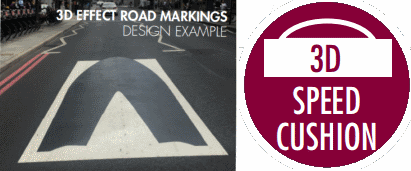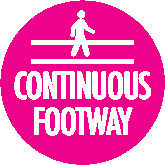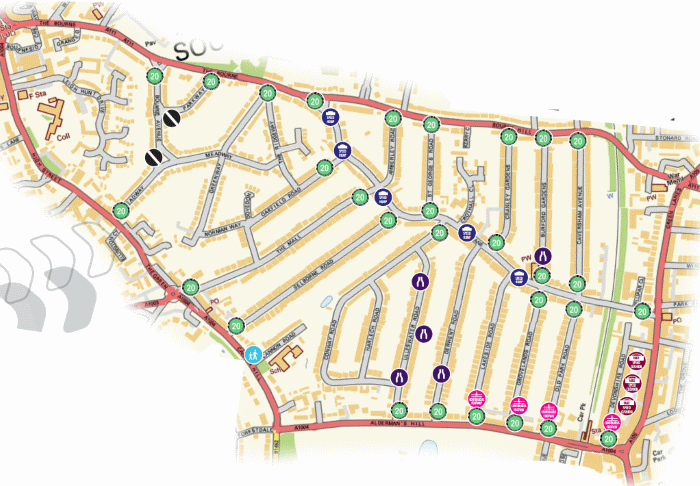Forum topic: Fox Lane Quieter Neighbourhood proposals published
Fox Lane Quieter Neighbourhood proposals published
PGC Webmaster
01 Nov 2017 14:03 #3296
- PGC Webmaster
-
 Topic starter
Topic starter
Share
![]()
![]() Share by email
Share by email
Details of proposed measures to create the Fox Lane Quieter Neighbourhood were published this morning. Like last week's plans for the Fernleigh Road QN, they take a holistic approach to reducing vehicle speeds along side roads throughout the large area covered, which stretches from Palmers Green Triangle nearly all the way to Southgate Circus.
Some of the traffic calming measures are familiar from the three previous QN proposals: speed humps (confined to Fox Lane itself), road narrowing, point no entries and a school street (affecting St Monica's). However, the consultation introduces some novel ideas.
All roads leading into the QN would have "entry points" consisting of a planter with low-level planting placed in the road. These planters will have neighbourhood signs to encourage drivers to stay below 20mph. The planters would require drivers entering the area to give way to those leaving. All turnings off Fox Lane would also be treated with entry points. The intention is evidently to make using the area as a shortcut between Aldermans Hill and Bourne Hill a less attractive option for drivers.
The other novel idea is the use of "3D-effect road markings", also referred to as "3D speed cushions". These use a "trompe l'oeil" effect to make a flat surface appear to be curved and have reportedly proved effective in reducing speeds in other parts of London. They would be introduced as an experiment in Devonshire Road.
The deadline for responding to the consultation is 26th November.
NEIGHBOURHOOD ZONE
 Residents expressed a wish to see the area covered by a 20mph zone to address their concerns about the speed and volume of through traffic in the area. However, they also did not want a lot of traffic calming features. To respond to this we propose to create entry points to the area indicating to drivers that this is a residential area. Each entry point will consist of a planter with low-level planting placed in the road. These planters will have neighbourhood signs which will encourage drivers to stay below 20mph. These planters will require drivers entering the area to give way to those leaving. Planters will be placed at junctions within the existing double yellow line areas so will not reduce parking. Planters will be maintained by the Council, but opportunities for community gardening can be explored. The location of the planters will remain flexible and we will monitor their placement to gain a greater understanding of the impact they may have. This could lead to trials where additional planters are placed along the length of residential streets and/or the existing planters are re-positioned to help further reduce traffic speeds/volume. Any additional measures such as these would see further community engagement.
Residents expressed a wish to see the area covered by a 20mph zone to address their concerns about the speed and volume of through traffic in the area. However, they also did not want a lot of traffic calming features. To respond to this we propose to create entry points to the area indicating to drivers that this is a residential area. Each entry point will consist of a planter with low-level planting placed in the road. These planters will have neighbourhood signs which will encourage drivers to stay below 20mph. These planters will require drivers entering the area to give way to those leaving. Planters will be placed at junctions within the existing double yellow line areas so will not reduce parking. Planters will be maintained by the Council, but opportunities for community gardening can be explored. The location of the planters will remain flexible and we will monitor their placement to gain a greater understanding of the impact they may have. This could lead to trials where additional planters are placed along the length of residential streets and/or the existing planters are re-positioned to help further reduce traffic speeds/volume. Any additional measures such as these would see further community engagement.
ROAD NARROWING
 Narrowing the road helps to reduce speeds, in several streets in the Fox Lane area we will reduce the width of the road by widening existing parking bays. Where marked parking bays already exist, we propose to widen these further to help reduce speeds in these streets.
Narrowing the road helps to reduce speeds, in several streets in the Fox Lane area we will reduce the width of the road by widening existing parking bays. Where marked parking bays already exist, we propose to widen these further to help reduce speeds in these streets.
3D EFFECT ROAD MARKINGS
 To reduce speeds on Devonshire Road (which is a one-way street) we propose to trial the use of painted 3D speed cushion road markings. In other London boroughs these have reduced speeds by several miles per hour without resorting to physical measures.
To reduce speeds on Devonshire Road (which is a one-way street) we propose to trial the use of painted 3D speed cushion road markings. In other London boroughs these have reduced speeds by several miles per hour without resorting to physical measures.
POINT NO ENTRY
 A point no-entry is used to prevent traffic travelling past a defined point in one direction while allowing traffic to continue in the opposite direction. A point no-entry is usually formed using a kerbed buildout to narrow the road, which may result in the loss of one or two on-street parking spaces. This is being proposed in response to residents’ concerns about the volume of through traffic using Bourne Avenue and Meadway.
A point no-entry is used to prevent traffic travelling past a defined point in one direction while allowing traffic to continue in the opposite direction. A point no-entry is usually formed using a kerbed buildout to narrow the road, which may result in the loss of one or two on-street parking spaces. This is being proposed in response to residents’ concerns about the volume of through traffic using Bourne Avenue and Meadway.
SPEED HUMP
 A speed hump is a traditional traffic calming feature used to slow traffic. Humps are typically round-topped and stretch across the width of the road. In response to residents’ concerns, we will be using a particular type of speed hump which is better for cyclists, and reduces noise and vibration to nearby residents. We are proposing to introduce speed humps in Fox Lane to ensure that our traffic management measures do not result in increased speeds.
A speed hump is a traditional traffic calming feature used to slow traffic. Humps are typically round-topped and stretch across the width of the road. In response to residents’ concerns, we will be using a particular type of speed hump which is better for cyclists, and reduces noise and vibration to nearby residents. We are proposing to introduce speed humps in Fox Lane to ensure that our traffic management measures do not result in increased speeds.
CONTINUOUS FOOTWAYS
 Continuous footways are made of materials similar to that of the surrounding footpath and vehicles are encouraged to give way to pedestrians who are using the footpath. This series of continuous footways will create an improved environment for pedestrians, linking the high street to the zebra crossing which provides access into Broomfield Park.
Continuous footways are made of materials similar to that of the surrounding footpath and vehicles are encouraged to give way to pedestrians who are using the footpath. This series of continuous footways will create an improved environment for pedestrians, linking the high street to the zebra crossing which provides access into Broomfield Park.
SCHOOL STREET
 A school street reduces high levels of congestion outside schools by closing the road to everyone but residents at specific times. The proposal is to close Cannon Road between 8.30 - 9.30am and 2.15 - 3.30pm to avoid traffic in the front of St Monica’s School.
A school street reduces high levels of congestion outside schools by closing the road to everyone but residents at specific times. The proposal is to close Cannon Road between 8.30 - 9.30am and 2.15 - 3.30pm to avoid traffic in the front of St Monica’s School.
Links
Please Log in or Create an account to join the conversation.
What a street in a Quieter Neighbourhood might look like
Karl Brown
01 Nov 2017 15:23 #3294
- Karl Brown
-

Share
![]()
![]() Share by email
Share by email
More green would be good to help break long vistas of tarmac; perhaps trees in the planter boxes and the opportunity for even more planters, and perhaps pocket parks, in street areas where working experience of the plan shows volumes and velocity of through traffic remain at inappropriate levels.
But after 30 years or so of waiting, to finally see a Council tabling positive steps to redress the balance between residents of a street and through traffic is extremely heartening. And of course if the impact unfortunately turns out to be pretty negligible in practice, with large wagons and speeding cars continuing, resulting in residents then pushing hard for very significant through-traffic restrictions, then such drivers would only have themselves to blame.
Please Log in or Create an account to join the conversation.
Fox Lane Quieter Neighbourhood proposals published
Bill Linton
01 Nov 2017 15:46 #3295
- Bill Linton
-

Share
![]()
![]() Share by email
Share by email
Happily no-one was hurt except for some minor injuries to the driver of the swerving car, but the wall was demolished and the car had to be ferried away on a lorry looking very sorry for itself. If there had been anyone on the pavement at the time they'd have been toast (and this was only a couple of hours before there were gangs of trick-or-treaters roaming the streets). A friend was hit in a similar swerve-onto-the-pavement-to-avoid-the-oncoming-maniac incident a few years ago, broke 3 limbs and was lucky to survive; afterwards she looked 10 years older. (That wasn't on the Lakes Estate).
Needless to say the other driver made himself scarce, though he did stop for a minute before driving off. That gave a witness time to get his number.
Please Log in or Create an account to join the conversation.
Fox Lane Quieter Neighbourhood proposals published
Darren Edgar
01 Nov 2017 16:00 #3297
- Darren Edgar
-

Share
![]()
![]() Share by email
Share by email
In short:
Neighbourhood zones I'm struggling to visualise. If that picture were the bottom of Ulleswater Road, per se, how the heck does a car turn off Alderman's Hill safely?! Also increased inconvenience & danger for cyclists to try navigate when turning off the same - eastbound will require breaking almost to a halt to turn off, at a point cars already drive to fast and close-pass. I could genuinely see a fatality.
Similar on road narrowing. Terrible for cyclsits as Wightman Road on the Haringay Ladder is testament to. Cyclists get squeezed by motor traffic which has no interest in being 'calmed' unless something bigger is heading the other direction.
Like the 3D though - love the ped xing example in Iceland recently.
School street - not sure the point. It's a dead end and most of the congestion is suffered on Conway Road and Cannon Hill - which will now suffer even more as a result.
Please Log in or Create an account to join the conversation.
Fox Lane Quieter Neighbourhood proposals published
Karl Brown
01 Nov 2017 16:53 #3298
- Karl Brown
-

Share
![]()
![]() Share by email
Share by email
Please Log in or Create an account to join the conversation.
Fox Lane Quieter Neighbourhood proposals published
Colin Younger
01 Nov 2017 18:09 #3299
- Colin Younger
-

Share
![]()
![]() Share by email
Share by email
I don’t think that signs or limits to access at the ends of these roads will prevent cars accelerating along them, particularly where there is a clear end to end view. Why don’t Lakeside, Grovelands and Old Park Roads warrant traffic calming measures other than at their end? Ulleswater has three road narrowings and Derwent one; are speeds so much worse there? It may be that the way ahead is with planters at various points which can be adjusted as experience is gained.
There seems likely be a problem for eastbound traffic on Aldermans Hill wanting to turn left and negotiating the newly narrowed junctions. The plans don’t make clear, at least to me, the physical relationship between continuous footways (which narrow junctions) and “neighbourhood zone” furniture (which also narrow the roads) at the south ends of Lakeside, Grovelands and Old Park Roads. I wonder how these will interact and affect traffic?
The traffic island at the junction with Lakeside already makes a left turn problematic; it’s common to have to wait in Aldermans Hill when vehicles are exiting Lakeside and the need to negotiate the narrowed junctions will make it riskier given the speed of Aldermans Hill traffic. It might help if there was less parking near the road junction.
As a matter of interest, the traffic monitoring device on Lakeside Road had it sensors cut through soon after it was installed. I wonder whether this was the only sabotage and whether it affected the outcomes?
Please Log in or Create an account to join the conversation.
Fox Lane Quieter Neighbourhood proposals published
David Hughes
03 Nov 2017 23:59 #3310
- David Hughes
-

Share
![]()
![]() Share by email
Share by email
More on the FLQN soon.
Please Log in or Create an account to join the conversation.
Fox Lane Quieter Neighbourhood proposals published
David Hughes
04 Nov 2017 14:08 #3311
- David Hughes
-

Share
![]()
![]() Share by email
Share by email
I'm fascinated by the difficulty of finding positions for 'build-outs' which is largely a problem of too many cars/too many concreted front gardens to make personal parking space. It would be a major task to reverse this situation, but people might like to try owning smaller cars (very many journeys are driver-only anyway), and hiring a larger/faster car for long journeys. That would probably be cheaper anyway, and make parking elsewhere easier.
And here's a thought: the widespread use of cars in cities and towns is under pressure worldwide. Perhaps we only have to wait.
Please Log in or Create an account to join the conversation.




